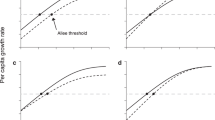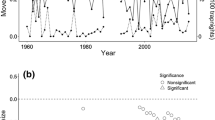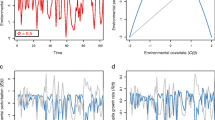Abstract
Explanations for the ubiquitous presence of spatially synchronous population dynamics have assumed that density-dependent processes governing the dynamics of local populations are identical among disjunct populations, and low levels of dispersal or small amounts of regionalized stochasticity (“Moran effect”) can act to synchronize populations. In this study we used historical spatially referenced data on gypsy moth (Lymantria dispar) outbreaks to document that density-dependent processes can vary substantially across geographical landscapes. This variation may be due in part to geographical variation in habitat (e.g., variation in forest composition). We then used a second-order log-linear stochastic model to explore how inter-population variation in density-dependent processes affects synchronization via either synchronous stochastic forcing or dispersal. We found that geographical variation in direct density-dependence (first order) greatly diminishes synchrony caused by stochasticity but only slightly decreases synchronization via dispersal. Variation in delayed density-dependence (second order) diluted synchrony caused by regional stochasticity to a lesser extent than first-order variation, but it did not have any influence on synchrony caused by dispersal. In general, synchronization caused by dispersal was primarily dependent upon the instability of populations and only weakly, if at all, affected by similarities in density-dependence among populations. We conclude that studies of synchrony should carefully consider both the nature of the synchronizing agents and the pattern of local density-dependent processes, including how these vary geographically.






Similar content being viewed by others
References
Aanes R, Sæther BE, Solberg EJ, Aanes S, Strand O, Øritsland NA (2003) Synchrony in Svalbard reindeer population dynamics. Can J Zool 81:103–110
Barbour DA (1990) Synchronous fluctuations in spatially separated populations of cyclic forest insects. In: Watt AD, Leather SR, Hunter MD, Kidd NAC (eds) Population dynamics of forest insects. Intercept, Andover, pp 339–346
Berryman AA (1996) What causes population cycles of forest Lepidoptera? Trends Ecol Evol 11:28–32
Bjørnstad ON (2000) Cycles and synchrony: two historical ‘experiments’ and one experience. J Anim Ecol 69:869–873
Bjørnstad ON, Falck W, Stenseth NC (1995) A geographic gradient in small rodent density fluctuations: a statistical modelling approach. Proc R Soc Lond B Biol Sci 262:127–133
Bjørnstad ON, Stenseth NC, Saitoh T, Lingjære OC (1998) Mapping the regional transitions to cyclicity in Clethrionomys rufocanus: spectral densities and functional data analysis. Res Popul Ecol 40:77–84
Bjørnstad ON, Ims RA, Lambin X (1999) Spatial population dynamics: analysing patterns and processes of population synchrony. Trends Ecol Evol 14:427–431
Blasius B, Stone L (2000) Chaos and phase synchronization in ecological systems. Int J Bifurcat Chaos 11:2361–2380
Blasius B, Huppert A, Stone L (1999) Complex dynamics and phase synchronization in spatially extended ecological systems. Nature 399:354–359
Cazelles B, Boudjema G (2001) The Moran effect and phase synchronization in complex spatial community dynamics. Am Nat 157:670–675
Engen S, Lande R, Sæther BE (2002) Migration and spatiotemporal variation in population dynamics in a heterogeneous environment. Ecology 83:570–579
Eyre FH (1980) Forest cover types of the United States and Canada. Society of American Foresters, Washington
Grenfell BT, Wilson K, Finkenstädt BF, Coulson TN, Murray S, Albon SD, Pemberton JM, Clutton-Brock TH, Crawley MJ (1998) Noise and determinism in synchronised sheep dynamics. Nature 394:674–677
Hanski I, Woiwod IP (1993) Spatial synchrony in the dynamics of moth and aphid populations. J Anim Ecol 62:656–668
Henttonen H, Hansson L, Saitoh T (1992) Rodent dynamics and community structure: Clethrionomys rufocanus in northern Fennoscandia and Hokkaido. Ann Zool Fenn 29:1–6
Johnson DM, Liebhold AM, Bjørnstad ON, McManus ML (2005) Circumpolar variation in periodicity and synchrony among gypsy moth populations. J Anim Ecol 74:882–892
Johnson DM, Liebhold AM, Bjørnstad ON (2006) Geographical variation in the periodicity of gypsy moth outbreaks. Ecography (in press)
Kendall BE, Prendergast J, Bjørnstad ON (1998) The macroecology of population dynamics: taxonomic and biogeographic patterns in population cycles. Ecol Lett 1:160–164
Kendall BE, Bjørnstad ON, Bascompte J, Keitt TH, Fagan WF (2000) Dispersal, environmental correlation, and spatial synchrony in population dynamics. Am Nat 155:628–636
Koenig WD (2002) Global patterns of environmental synchrony and the Moran effect. Ecography 25:283–288
Lande R, Engen S, Saether BE (1999) Spatial scale of population synchrony: Environmental correlation versus dispersal and density regulation. Am Nat 154:271–281
Legendre P (1993) Spatial autocorrelation: trouble or new paradigm? Ecology 74:1659–1673
Liebhold A, Kamata N (2000) Are population cycles and spatial synchrony a universal characteristic of forest insect populations? Popul Ecol 42:205–209
Liebhold AM, Koenig WD, Bjørnstad ON (2004) Spatial synchrony in population dynamics. Annu Rev Ecol Evol Syst 35:467–490
Moran PAP (1953) The statistical analysis of the Canadian lynx cycle. II. Synchronization and meteorology. Aust J Zool 1:291–298
Peltonen M, Liebhold A, Bjørnstad ON, Williams DW (2002) Variation in spatial synchrony among forest insect species: roles of regional stochasticity and dispersal. Ecology 83:3120–3129
Ranta E, Kaitala V, Lindström J, Lindén H (1995) Synchrony in population dynamics. Proc R Soc Lond B Biol Sci 262:113–118
Ranta E, Kaitala V, Lindstrom K, Helle E (1997) The Moran effect and synchrony in population dynamics. Oikos 78:136–142
Ripa J (2000) Analysing the Moran effect and dispersal: their significance and interaction in synchronous population dynamics. Oikos 89:175–187
Ripa J, Ives AR (2003) Food web dynamics in correlated and autocorrelated environments. Theor Popul Biol 64:369–384
Rosenblum MG, Pikovsky AS, Kurths J (1996) Phase synchronization of chaotic oscillators. Phys Rev Lett 76:1804–1807
Roughgarden JD (1975) A simple model for population dynamics in stochastic environments. Am Nat 109:713–736
Royama T (1992) Analytical population dynamics. Chapman & Hall, London
Royama T (2005) Moran effect on nonlinear population processes. Ecol Monogr 75:277–293
Saitoh T, Stenseth NC, Bjørnstad ON (1998) The population dynamics of the vole Clethrionomys rufocanus in Hokkaido, Japan. Res Popul Ecol 40:61–76
Tkadlec E, Stenseth NC (2001) A new geographical gradient in vole population dynamics. Proc R Soc Lond B Biol Sci 268:1547–1552
Turchin P (2003) Complex population dynamics: a theoretical/empirical synthesis. Princeton University Press, Princeton
Williams DW, Liebhold AM (1995a) Detection of delayed density dependence: effects of autocorrelation in an exogenous factor. Ecology 76:1005–1008
Williams DW, Liebhold AM (1995b) Influence of weather on the synchrony of gypsy moth (Lepidoptera: Lymantriidae) outbreaks in New England. Environ Entomol 24:987–995
Williams DW, Liebhold AM (2000) Spatial scale and the detection of density dependence in spruce budworm outbreaks in eastern North America. Oecologia 124:544–552
Yodzis P (1989) Introduction to theoretical ecology. Harper and Row, New York
Acknowledgements
We thank E. Luzader for technical assistance. Esa Ranta and Jörgen Ripa provided very useful comments on an earlier version of this paper for which we are grateful. This work was supported by United States Department of Agriculture National Research Initiative Grant #2002-35302-12656.
Author information
Authors and Affiliations
Corresponding author
Electronic Supplementary Material
Rights and permissions
About this article
Cite this article
Liebhold, A.M., Johnson, D.M. & Bjørnstad, O.N. Geographic variation in density-dependent dynamics impacts the synchronizing effect of dispersal and regional stochasticity. Popul Ecol 48, 131–138 (2006). https://doi.org/10.1007/s10144-005-0248-6
Received:
Accepted:
Published:
Issue Date:
DOI: https://doi.org/10.1007/s10144-005-0248-6




